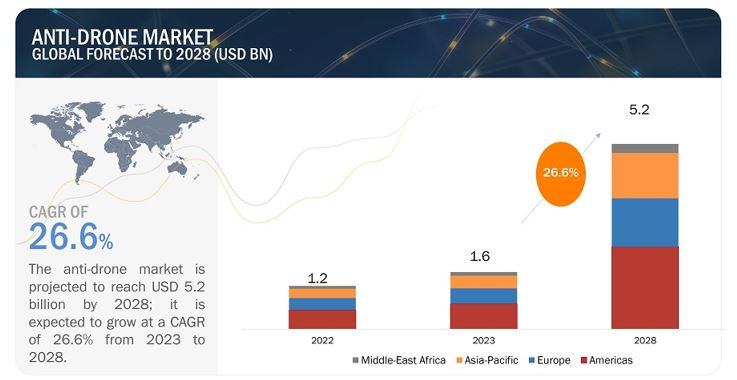Chicago, June 27, 2024 (GLOBE NEWSWIRE) -- The global anti-drone market was valued at USD 1.2 billion in 2022 and is projected to reach USD 5.2 billion by 2028; it is expected to register a CAGR of 26.6% between 2023 and 2028 The rise in demand for anti-drone systems is attributed to the increasing government spending on counter-drone technologies, rising incidence of critical infrastructure security breaches by unauthorized drones, and Surging adoption of aerial remote sensing technologies to safeguard critical infrastructure.

To know about the assumptions considered for the study.
Major Anti-Drone Companies Include:
- RTX (US),
- Lockheed Martin Corporation (US),
- Leonardo S.p.A. (Italy),
- Thales (France),
- IAI (Israel),
- Rafael Advanced Defense Systems Ltd. (Israel),
- Blighter Surveillance Systems Limited (UK),
- DroneShield Ltd (Australia),
- Dedrone (US).
Anti-Drone Market Segmentation Analysis:
By technology, the kinetic system segment is expected to grow with the highest CAGR from 2023 to 2028
The anti-drone market for the kinetic system segment is expected to grow at the highest CAGR from 2023 to 2028. Kinetic systems offer versatility and reliability, making them capable of countering drones across various threat levels and adapting to evolving drone technology. Their immediate threat mitigation capabilities are essential, particularly in scenarios where rapid response is crucial, such as safeguarding critical infrastructure or securing high-profile events. Kinetic systems have also demonstrated a high success rate in physically disabling drones, effectively preventing potential harm or damage.
By vertical, homeland security is expected to grow with the highest CAGR in 2028.
Homeland security is expected to exhibit the highest CAGR in the anti-drone market during the forecast period. The growth can be attributed as the escalating threat posed by drones, the need for advanced technology to counter these threats, the emergence of swarm drone capabilities, and a heightened awareness of the potential risks.
By platform type, the UAV-based segment is expected to grow with the highest CAGR during the forecast period.
The anti-drone market for the UAV-based segment is expected to grow at the highest CAGR from 2023 to 2028. The growth of UAV-based anti-drone systems is driven by the need for robust countermeasures against unauthorized or potentially malicious drones. Also, the ability to deploy countermeasures from UAVs themselves allows for more flexible and efficient responses to drone threats, enhancing security measures.
In 2028, Asia Pacific is projected to hold the highest CAGR of the overall anti-drone market
In 2028, Asia Pacific is projected to account for the largest share of the anti-drone market. The factors contributing to the regional market’s growth include the development of a broad range of counter-drone technologies to prevent drone-related crimes and several ongoing research and development activities by the market players in the region.
Anti-Drone Market Size and Share
The anti-drone market is experiencing significant growth, with projections indicating a rise from USD 1.2 billion in 2022 to USD 5.2 billion by 2028, reflecting a robust compound annual growth rate (CAGR) of 26.6%. This market expansion is driven by increasing concerns over unauthorized drone activities, prompting the development and deployment of advanced counter-drone technologies across various sectors. Key regions contributing to this growth include the Asia Pacific, which is expected to lead the market due to extensive research and development initiatives and the adoption of comprehensive counter-drone measures to address security threats.
Anti-Drone Market Industry Overview
The anti-drone market is undergoing rapid evolution, driven by the increasing prevalence of unmanned aerial vehicles (UAVs) and the corresponding need for effective countermeasures. The growth of market is fueled by rising security concerns across military, government, and commercial sectors. Advanced technologies such as radar systems, radio frequency jamming, and laser-based solutions are at the forefront of this industry, offering robust detection and neutralization capabilities. Key market players, including Lockheed Martin, Thales Group, and Raytheon Technologies, are investing heavily in research and development to enhance the effectiveness and efficiency of their anti-drone solutions. Additionally, regions like North America and Europe dominate the market due to their significant defense expenditures, while the Asia Pacific region is rapidly emerging as a key player due to extensive R&D activities and increasing adoption of anti-drone technologies.
